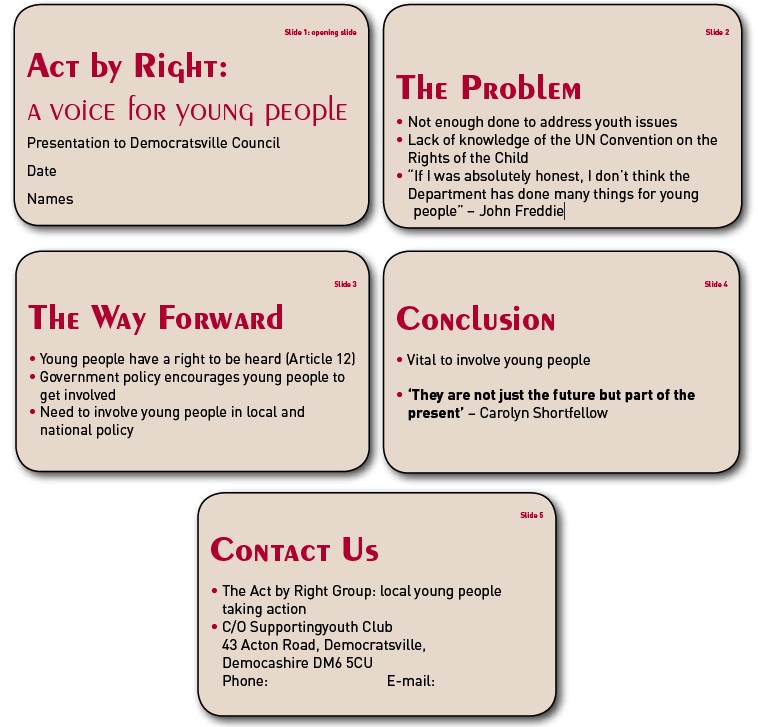4.2(a) Listen to this
Aim
To prepare a short presentation.
You need
Your poster, leaflet, newsletter and the news release, paper and pens and at least an hour. A computer with PowerPoint will be very useful.
What to do
This first activity helps you get your message across by designing a presentation for use in public – at a meeting you have been invited to or one you are running. Many of you will be familiar with using PowerPoint. This is a programme to help prepare presentations, through creating a series of slides. These can be projected or printed for use with an overhead projector.
a) First, have a look at the article below from young people at a national Government conference. Decide the key messages and mock up five slides. Then look at the slides below the article and see how they compare. Names have been changed or omitted.
The article
Government Department fails children and young people
The truth is out. An important Government Department admits that it has not done much to address youth issues. In an interview following his keynote speech, John Freddie said ‘If I was absolutely honest, I don’t think the Department has done many things for young people.’
This shocking truth comes in a climate when encouraging young people to get involved in Government policy is all the rage. Carolyn Shortfellow said that it is vital to involve young people, as ‘they are not just the future but part of the present.’ Freddie was also asked whether he was aware of Article 12 of the Convention on the Rights of the Child. His reply was vague.
But, Government is not the only one not up to speed. In interviews with delegates, very few knew of Article 12, which confirms in international law children and young people’s rights to participate in matters affecting us.
Most people at the conference agreed more should be done. Young people should be involved at every level of neighbourhood decision-making and be able to influence national and local policy.
Example of presentation slides
b) Having had a dry run, prepare your own ten-minute presentation. You will rarely have longer to get your message across. Get into small groups to encourage everyone to share ideas and develop skills. Make sure each group has a copy of the communication methods you have already created. Draw out a maximum of ten key points – and that includes who you are and your contact details. Take up to ten sheets of paper and draw a horizontal line half way down. On the top half, put a heading for each slide with three points underneath and certainly no more than six. Quotes can be powerful but they must be brief. These will be your slides that the audience will see. Add any notes to guide you as you speak in the bottom half.
c) Come back together, share what you’ve done and agree the final group presentation together. Or you may want to keep more than one for different audiences. It may now need a volunteer or two to create the presentation on to PowerPoint, but it is worth as many as possible having a go. Follow the simple guidelines below to make sure your presentation does the job. ‘Death by PowerPoint’ tends to happen when audiences are baffled by technical wizardry, text flying in from every angle, accompanied by distracting noise. Remember to keep it simple. You don’t want to detract from your message.
PowerPoint guidelines
- Use an uncluttered template or background. There is a choice in the PowerPoint programme, or design your own with your logo.
- Use a clear font like Ariel. Never go below point 18. Audiences just can’t read it.
- Use colours sparingly and rarely more than two. Black is usually fine.
- Be careful not to be distracting with fancy slide animation. It usually gets in the way.
- Be consistent from slide to slide.
- Keep the message simple on each slide. Don’t clutter. Use headlines, not sentences, unless you are quoting. And keep quotes brief.
- Remember, what’s on the slide is a pointer to what you are going to say. It does not duplicate everything you intend to say. Add in your notes underneath the slide.
- Photos, video and sound clips can be imported into PowerPoint. But the same rules apply: make sure these add to your message and don’t just look clever.
- Make sure everything is working properly.
What do you think?
How do you feel about your presentation? Of course, someone still has to stand up and deliver it, but a clear, crisp, well-produced presentation should give you confidence. You can print a version with your notes underneath by going to file – print – print what – notes page. It can be helpful for those listening to have their own copy, with space to add their own notes. Go to file – print – print what – handouts and select three slides to a page. Photocopy the number you need. The next activity gives you the chance to practise your presentation in a range of settings.

